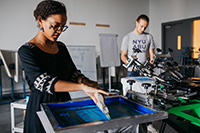-
Academics
-
Admissions
 Your journey to NYUAD starts here. Attend an application workshop or information session.Admissions Events
Your journey to NYUAD starts here. Attend an application workshop or information session.Admissions Events -
Research
-
Campus Life
 Live the possibilities. Be part of a dynamic community of students from over 115 countries.Take a Tour
Live the possibilities. Be part of a dynamic community of students from over 115 countries.Take a Tour - Public Programs
-
About
Exceptional education. World class research. Community-driven.Our Story
- News
- Events
- Social Media Directory
- Press Room
-
- Faculty
- Current Students
- Alumni
- عربي
Research
A Generic Supercritical CO2 Process for the Creation of Nano-Scale Wires And 3-D Meso-Scale Porous Structures for a Large Class of Inorganic Materials And Alloys
This process utilizes the capillary forces, which are generally intrinsic to such small systems, to direct the assembly process. In our experiment, we aimed to avoid agglomeration of particles in order to enable the tendency to self-assemble by managing the location and time of evaporation. We have developed a process that forces the evaporation from individual water-droplets to occur closer to the substrate where the particles are to be collected, thereby minimizing agglomeration. Also, we have discovered that the capillary and fluid shear forces available at the substrate surface facilitate self-assembly of these nanoparticles to create nano-wires and nano/meso-scale, porous 3-D structures. Our research is focused on developing a robust, generic process platform that balances the rate of evaporation from individual droplets with the coalescence rates of the droplets at the substrate to generate nano-scale structures for a broad class of inorganic materials.
Application of Calcium Carbonate Scaffolds Fabricate by Supercritical (sc)-CO2 for Tissue Engineering
In this study porous CaCO3 scaffolds were fabricated by using sc-CO2 assisted nebulization. The resulting scaffolds comprises hierarchical micro and and nanoporous of 2±1 µm and 50 ± 14 nm, respectively. The scaffolds building block was formed as a results of coffee-stain effect on dried nebulized nanoparticles. The surface morphology is analyzed by scanning electron microscopy (SEM) and atomic force microscopy (AFM). X-ray Diffraction spectra showed that the CaCO3 is composed of calcite polymorph. The scaffold shows good bioactive property and is using for study of cell culture for implant application.
Fabrication of ZnO Nanostructures Using Supercritical Technologies
Various techniques are available to prepare ZnO nano-structures viz. chemical vapor deposition, laser ablation, sputtering, hydrothermal process, and many more, but most of these fabrication techniques need sophisticated equipment and rigorous experimental conditions. Out of above supercritical fluid technologies have been demonstrated as green and effective route for nano-structure synthesis and processing.
Supercritical processing provides an alternate for the scalable production of nanostructures and nanodevices are of interest for numerous optical and electronic device applications. Supercritical fluids are the versatile media offering potential advantage in particle size control, high temperature synthesis and product repeatability.
We have synthesized ZnO nanowires, nanorods, and other nanostructures using supercritical CO2 media. These nanostructures are attractive components for nanoscale electronic, optical, and photonic device applications because of their advanced characteristics. Recently, ZnO nanostructures have been used for a variety of nano-devices applications including ultraviolet photodetectors, FETs, diodes, gas sensing, light emitting device arrays, etc.
De-wetting Thin Film
The fabrication of low-dimensional nanostructures offers an emerging route toward miniaturization of device components with enhanced performance and functionality. Apart from conventional strategies, de-wetting of thin films has generated immense interest as an alternate in non-masking methods for self-assembled nanostructure production. We have explored dewetting characteristics of thermal evaporated ultra-thin films prepared from Ag, Al, Au, and etc., as well as alloys for the production of self-organized nanostructures.
Such low-dimensional nanostructures provide a promising building block for the fabrication of various miniaturized devices and systems for applications in electrochemical, biological, and energy-related fields, Micro-fluidics, and related areas, but also as a potential bio-micro platform to promote the advancement of bionanotechnology.
Characterization of Micro-algal Cells
The rapid and reliable detection of micro-organisms with a high grade of sensitivity and selectivity is quite challenging for various emerging fields, e.g., clinical diagnosis, bio-fuels, pharmaceutical, and etc. Biofuels, an alternative to conventional fuel created from renewable biological sources such as vegetable oils and animal fats. From biodiesel perspectives, Algae has demonstrated rapid growth, high productivity, acts as a dominant feedstock to store oil with high energy conversion efficiency. It contains proteins, carbohydrates, lipids (fatty acids), and nucleic acids in different proportions.
Vibrational spectroscopic techniques have created a number of technical and scientific advancements for identification and quantification of various microorganisms for bulk environment as well as single-cell analysis. Raman-spectroscopy is exclusively adapted for biological applications as it offers better contrast and ability to examine liquid samples than IR. For micro-algae characterization, we use Confocal Raman Microscopy (CRM), a combination of confocal optical microscopy with Raman spectroscopy with adaptable data acquisition rates for quick and reliable differentiation of fatty acids in algal cells. The chain length and degree of unsaturation of fatty acids for diverse algal samples have calculated.
Biomaterials Synthesis in sc-CO2 Formulations
Extension of the molecular-cluster assembled materials to bioengineering would solve an important problem in the field of rapid analysis of bio-molecular interactions, which is essential to detection of genetic polymorphisms, analysis and discovery of metabolic pathways, characterization of mechanisms of drug action, and adverse drug response, and deciphering of the molecular basis of life processes. Biomolecules are typically printed from aqueous mixtures, making the process highly susceptible to variations in ambient humidity, surface wetting phenomena, and surfactancy behavior of the molecules being deposited leading to non-uniform deposition coverage, effectively altering the surface concentration of the capture species, and making the extent of binding between targets and capture molecules extremely difficult to quantify via automated algorithms that are necessary to process thousands of reactions per experiment. When printed from sc-CO2 formulations, we expect to be able to deliver precise amounts of these bio molecules which are expected to form uniform self-assembled films on specific array sites.
Our study with pharmaceutical materials to create molecular clusters of drugs (e.g., insulin), would enable drugs that could cross the blood brain barrier, novel drug delivery systems such as non-contact injection directly into the blood stream through the skin, and drugs directly printed inside carrier materials.
Nanoindentation of Organic Thin Film
In this study we reported a newly formation of free standing, hydrophobic thin film of Teflon AF 1600. The thin film is formed via self-assembly of nanoparticles at both air/water and oil/water interface of micro-emulsion droplets. Surface morphology of thin film is characterized by scanning electron microscopy (SEM) and atomic force microscopy (AFM). XRD spectra at low angle showed the presence of organic nanosheets of 6 nm thick. The mechanical properties of such robust thin film was intensively examined by nanoindentation methods which demonstrated “sliding tablets” mechanism, similar to nacre, to dissipate applied stress.
Synthesis of surfactant-free dispersion and superhydrophobic Film by Supercritical CO2
We developed a straightforward and high yield technique to synthesize and collect nanoparticles of amorphous Teflon AF 1600. The technique is a modification of Rapid Expansion of Supercritical Solution (RESS) where the the polymer is dissolved in supercritical CO2 at 300 bar and 60 ◦C. The synthesized nanoparticles were collected in a dry-ice trap and dispersed in inorganic solvents. Free standing superhydrophobic (water contact angle adv = 162◦) is formed via self-assembly of nanoparticles at water-air interface.
Molecular Clusters and Cluster Assembled Solids
This work is based on the pioneering research by a group of scientists at Kodak, under leadership of Professor Jagannathan, that have led to the development of a supercritical CO2 based process for the synthesis of stable molecular clusters of a number of organic materials. The molecular clusters with size in the range 1-10 nm, were quite stable with lifetimes greater than two years and also exhibited a strong dependence of photoluminescence (PL) on the precipitation process parameters. Photoluminescence was tunable over 10-100 nm and new PL features could be resolved depending on precipitation conditions. They demonstrated a strong tendency to readily self assemble into (micron thick) three dimensional superlattice structures on various substrates at room temperature. The molecular clusters were liquid-like at room temperature. In one example, their super-hydrophobic property extended through an overcoat of 20 nm thick gold/palladium. Efficient, functional OLED devices were built with these molecular cluster films implying efficient electrons and holes transport.
This work is exciting because it opens up a new class of organic nanomaterials held together by weak van der Waals forces that are exceptionally stable and possess properties that rival their inorganic counterparts, even in the absence of an ordered structure or quantum confinement effects.
At NYUAD Engineering, we continue this new field of research, confirm and establish these novel phenomena on a solid foundation for a broad class of materials, improve the precipitation process to generate reliable data for a number of materials and generate sufficient data to enable new theoretical insights and spur new research.
* These pictures are pre-peer reviewed version of the following articles:
R. Jagannathan and G. C. Irvin, Nanofluids: A new class of materials produced by nanoparticles assemblies, Adv. Funct. Mater, 2005, 15, 1501. DOI : 10.1002/adfm.200400474
R. Jagannathan and R. V. Mehta, Continuous atmospheric process to create clusters and nanostructured, functional materials, Adv. Funct. Mater. 2006, 16, 633. DOI : 10.1002/adfm.200500601
R. Jagannathan, G. C. Irvin, T. Blanton, and S. Jagannathan, Organic nanoparticles: Preparation, self-assembly, and properties, Adv. Funct. Mater. 2006, 16, 747. DOI : 10.1002/adfm.200600003
